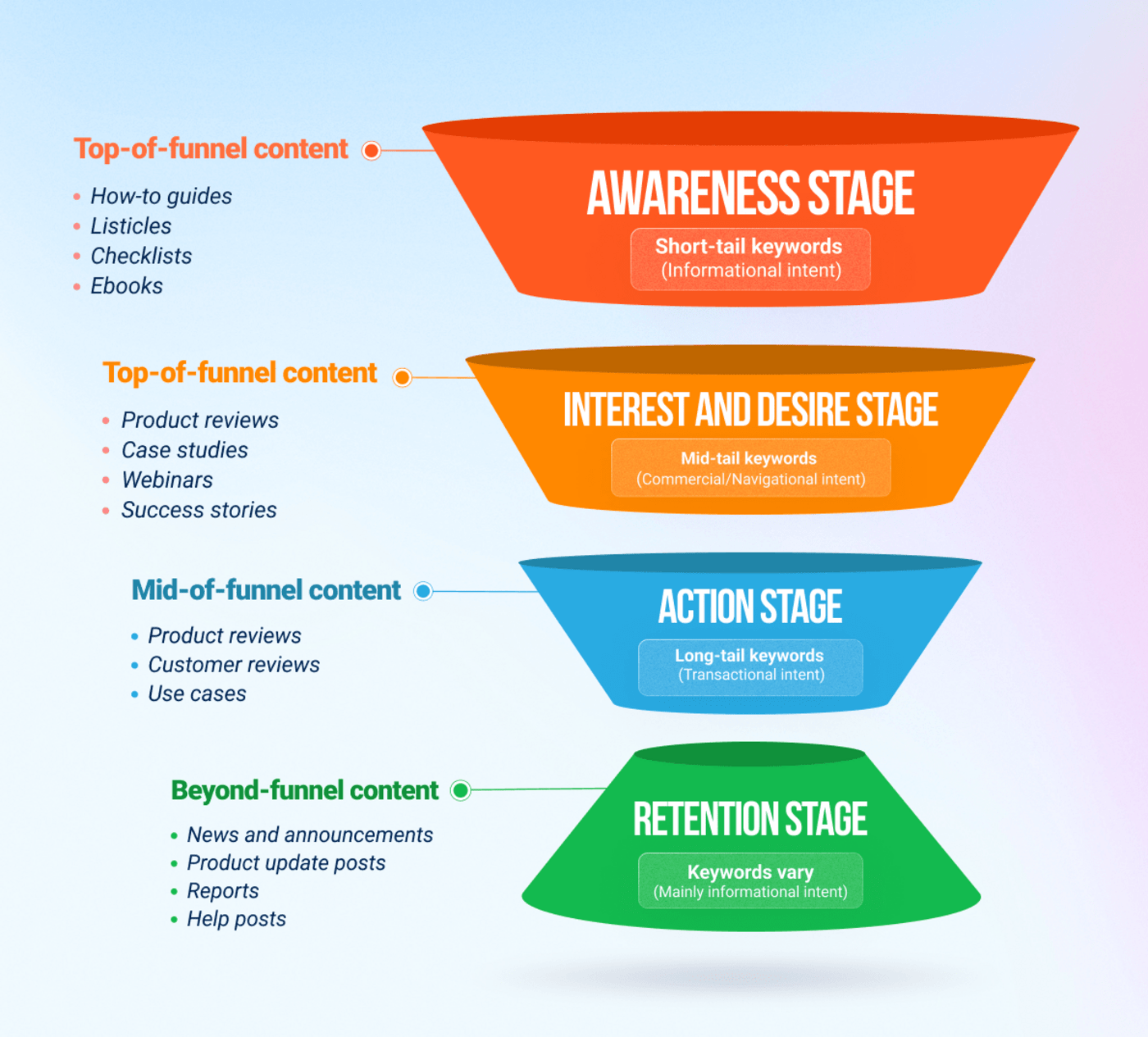SEO Content Gap Analysis: Outrank Competitors in 9 Steps

Are you creating your content based on hard data or just intuition?
Your answer to that could be why your competitors are enjoying the top spots in search results while you’re left struggling not to fall off the SERPs altogether.
Still, let’s be real – creating interesting posts on a regular basis is hard. It’s even worse when you’re looking for inspiration in all the wrong places.
So, in this guide, we are going to make your work easier by giving you a key to constant “inspo” for the fresh publications – your competitors. You’ll learn how to analyze gaps in website traffic and use that to get the creative juices flowing again.
What is a content gap analysis?
An SEO content gap analysis basically describes a process where you put all the pages and posts on your competitor's website (and your own) under a figurative microscope. Why?
Because you want to identify missed opportunities and weak points in already existing pieces.
No matter how good and thorough your competitors are, chances are that there are some “holes” in their content – some topics that they might be missing out on.
But your target audience could still be looking for this information online. So, by finding these topics, these gaps, you could fill them in and give your potential clients what they need.
The cool thing about this tactic is that it takes the guesswork out of marketing planning. You'll be using real hard data to find opportunities that match what your target customers really want. And you won’t have much competition there.
So, this is how it can help you:
- Find the keywords and search intent gaps your competition is missing out on.
- Check whether there are topics you don’t cover while other brands do.
- Discover the topics that will drive more traffic to your site.
- Improve your topical authority and search rankings.
- Outperform other businesses in your niche.
Here's the thing: if no one else discovers it first, and you create new pieces around it, you become the company that corners that traffic that your competitors are missing out on.
You become the business that fills their needs, and so they trust you and buy from you (if the copy is good and the intent is right, of course).
Ideally, you want your article posting service to do the same thing if you ever get one for your link-building. The only links that matter are relevant links from quality DR sites with good traffic that are placed naturally in content that matches search intent. See how that works?
All in all, knowing the needs your target audience has can help you improve your posts and conversions while getting much better SEO results.
Different types to consider
Let’s put it straight – the gap research can take many different forms. So, it will depend on your goals and the tactics you prefer. But let’s recap four major ones to give you an idea of what direction you could take:
1. Competitor-based
This type of competitive gap analysis involves focusing on your competitors' websites.
Your goal?
To figure out their content strategy, acquisition channels, target market, and everything else in between.
You will compare all these against your situation to see what’s working for them, what’s not, and what they are missing out on that you can take advantage of. It also works vice versa, meaning that you can check what you are missing out on that they aren’t.
That means looking into:
- The keywords they are ranking for that you are not,
- Their top-performing pages and the idea/message behind them,
- The content types they use (the ones that work well and not so well for them),
- The different segments of the audience they try to target with their posts (have you been overlooking any part of potential clients?), etc.
It is pretty important to do this checkup every now and then (at the very least once a year, better if quarterly). This way, you’ll get a better understanding of the current situation in your niche, giving you space to improve and know how to differentiate.
2. Buyer-based
The buyer-based research is all about finding which content is missing for each stage of your buyer's journey.
There are different stages of a buyer's journey, and each customer can come into your sales funnel through any of them.
So, you want to make sure that your posts cover all the stages and guide the customer towards the bottom of your sales funnel.
For example, you might have lots of pieces for those at the Awareness stage, but not enough publications for people who are at the Decision stage. This could be a problem that leads to lower conversions.
So, by taking this step, you can identify this issue early and fix it as soon as possible.
But since today, we’re talking about comparing your tactics to what other brands are doing, make sure you check the following:
- What type of posts and formats are your competitors using for every stage of the funnel?
- Do they use different channels for every stage (if so, what are those?)?
- How does it all work for them, and do you do things differently?
3. Topic-based
The goal here is to find the topics your potential clients are searching for, but you haven’t written about them yet. Ideally, at this stage, you want to identify more content opportunities that have great potential to bring you relevant traffic.
This is something that can help you improve your topical authority, which is great for both SEO and your overall brand.
Your ultimate objective should be to become the go-to voice in whatever it is you’re selling. While it takes lots of time and effort, you want to achieve the same level of recognition as they did:
- The Verge? All things tech.
- NerdWallet? Personal finance.
- Your brand? Your main topic.

useful thing you can do here is to find pages and posts that could be
improved. You should pay special attention to the ones with missing,
incorrect, or outdated information.
By freshening up those pieces, you can make your website more relevant for search engines and your audience. As a result, you’ll have publications that actually match the search intent, help you drive traffic, and build your authority in the industry.
4. SERP-based
The SERP-based research involves all things SEO. While all the types we’ve mentioned before have also touched on search engine optimization, here, you want to go even deeper. This includes:
- Analyze your keywords. The goal is to figure out what sites are ranking well for your target queries, why they are ranking, and what gaps you are missing that can give you that badly needed search visibility.
- Understand the search intent. Check how those keywords match the search intent so well that they outranked you. You might notice that, for example, your content formats aren’t the same as the ones on the top-ranking pages.
- Check SERP features. Maybe you didn’t show up in Featured Snippets, People Also Ask, AI overviews, etc., while your competitors did. Usually, this means that they are directly answering the popular questions people ask, and you are not doing the same.
- Do a backlink analysis. Who mentions other brands in your niche? Do they use guest posting? Rely on linkable assets? Or heavily use PR? Whatever that is, you want to know, as backlinks are a huge ranking factor. You can even find the brands that have similar backlink profiles to yours.
Source: Semrush
Of course, there are other things you can analyze as well. And we’ll look into them further below.
9 steps to find keyword gaps
Now that you know how to keep your eye on the content strategy of your competitors. The next step is to learn how to find those missed opportunities easily. These are nine quite straightforward steps we recommend:
1. Know your opponents well
It will be quite hard to identify gaps and opportunities without first knowing who your competitors are. How do you do this? There are a few major ways. Let’s go through each of them next:
SEO tools
Using SEO software is one of the most popular ways to find other brands that compete with you, especially if you want to outrank them later on.
You can pick any tool you like for this. Think Semrush, Moz, Ahrefs, or any other you prefer.
Typically, they work as follows: you enter your domain, and it shows you websites ranking for the same and similar keywords to the ones you target.
Source: Semrush
The manual way
If you don’t want to use any software, you can go the old way. For this, you will have to enter your keywords into a search engine and then find the sites that consistently pop up among the top ten results for your target queries.
Source: Google
Creative alternatives
Besides, you can use more creative ways to find competition, like:
- Ask the customer support for other brands that your clients have mentioned as alternatives to you.
- Consider your indirect competitors that rank for 30%+ of your keywords.
- Check review sites to find what other businesses people mention when they talk about you.
- Look through the comments in online forums and communities to see what replacements people are recommending apart from (or over) your offering.
If you follow the steps above, you will find both your indirect and direct competitors. The idea is to spread your net wide so that you get a rich perspective and more opportunities.
2. Analyze their data
Now that you know who your competitors are, you can move on to the next step.
What is it?
You should make a list of 5-10 sites that are your direct competitors. For example, if you sell affordable, eco-friendly phone cases, then your competitors could be similar brands doing the same or offering an alternative to your product.
Source: Google
Why pick only 5-10? Because otherwise, it will get overwhelming in the long run.
Sure, it’s really useful to analyze all the possible competition you have once a year or something like that.
But if you want to be flexible and adjust fast to the market changes, you have to choose around five brands that are very similar to your offering, meaning they:
- Target the same audience,
- Have a similar pricing policy,
- Offer the same product/service.
Next, after you know who you have to focus on, you can start going through your competitors' content and taking notes of their keywords. You especially want to pay attention to the ones that help them outrank you, so you understand how they got an edge over you.
Here, you can start by using an SEO tool to give you the initial information about the opportunities you miss. For example, Semrush has this Keyword Gap solution that helps you see how you’re doing compared to other brands.
Source: Semrush
You’ll see tons of data with any SEO tool, so it’s easy to get lost. But instead of feeling overwhelmed, you can concentrate on the organic keywords they rank for and analyze the following:
- The ranking position of each of these keywords.
- Their monthly search volume.
- The content on the pages where those queries appear.
- Which of those are featured in featured snippets, local packs, etc.
Sounds like a lot of work, but again, if you don’t try to analyze hundreds of brands out there, it won’t be that complicated. Besides, SEO software makes the whole process quite straightforward.
And if your use case is somehow more complex, there is a tool to automate almost any SEO process, so just search for what you need to simplify your repetitive tasks.
As you make your findings about all those keywords, make sure you keep a handy list that clearly shows all the data. Because, you know, things can get quite messy quite fast.
Most tools allow you to export your data as a .csv file, so this is a great feature to keep track of everything.
Source: Semrush
Still, should you select every single keyword that other brands in your niche are ranking for?
No, of course, not.
These are the types of keywords to discard during your research:
- Branded keywords (you can rank for something like Other Brand vs. Your Brand, but ranking for just Other Brand’s Name is, well, useless).
- Keywords outside your niche (no matter how high their traffic potential is). You don’t need traffic just for the sake of it, right?
- Search queries with abnormally low search volume (it’s a complete waste of time and budget to make posts around topics no one wants to read).
- Very hard-to-rank-for keywords (no matter how high the search volume is). That is, unless you are a big business with DR80+ and the budget to handle very competitive keywords.
- Keywords you’ve already covered (it’s better to add a couple of additional search queries to the already existing pieces if you have to, instead of crafting something new that will cannibalize your other page).
- Queries with unclear search intent (ideally, every time you write anything, you have to think about why you do that and how it could help your company. If it isn't helpful and doesn’t bring you any closer to your business goals, then why?)
Now that we’ve covered what keywords to drop and which ones to use, let’s also talk about what to do with the ones you do decide to keep. This brings us to the next content gap analysis tip.
3. Segment all the information
Now, you have your queries, what’s next? You are going to need to analyze them so that you can segment them properly. It’s absolutely necessary to clearly see the best opportunities.
What’s the best way to group all those phrases? It depends, really.
The idea is to sort keywords by their similarities, but how you do that is totally up to you.
This could be done based on:
- Search intent.
- Relevance to your target audience.
- Buyer journey stages.
- Product-relevance.
- Long-tail vs. short-tail.
- Metrics like search volume, traffic, etc.
- Backlink-attraction potential.
Still, you want all related ones next to each other on the same list. Even if you start with one query, try to add those additional keywords that are similar in essence (meaning, search intent, etc.).
So, in the end, it will look similar to this (yes, search volume and keyword difficulty are two great metrics to add):
Lists like this will greatly help you create quality, optimized copy afterward. It’s because this structure allows you to build topical authority over time as you explore each subject in depth. So, instead of creating thin, superficial pieces, you will give answers your readers need.
Besides, at this stage, you’ll also find several queries that aren’t really relevant that you've missed at the previous step. It’s totally normal, just remove them, as well as any duplicate keywords and content overlaps.
4. Turn the mirror on yourself
At this point, it’s time to leave competitors aside for a moment and look at your current situation. It's important that you audit yourself to know where you stand in comparison with other brands in your niche.
So, how do you identify content gaps on your website? Pretty easy.
Use the same SEO tools to export your current keyword list along with their rankings, search volume, and other data.
Just like with your competitors' keywords, you want to group the publications on your site by topic, intent, and performance:
- What keywords are you targeting with each of your pages?
- What are their ranking positions, search intent, and CTRs?
- What pages get the most organic traffic and why?
It’s your opportunity to get a clear idea of where you stand and how well all your posts are doing.
This is also a great way to discover whether there are some topics that you covered but only did so partially. If that’s the case, think of the articles you need to write, rewrite, or optimize to “complete” your keyword clusters.
Source: Semrush
This part of your research will also help you understand which search query gaps you need to prioritize. It’s always better to first do all the quick fixes and then proceed with the more substantial tasks.
5. Build a better plan
Now is the time to tweak your current publications or create entirely new ones from scratch.
You can use the RICE method here. While it isn’t a popular model in SEO, we like how it helps decide which keywords to prioritize first in your current plan.
That would mean paying attention to:
- The monthly Reach of the keyword.
- Impact of rankings for that keyword on your business (does it bring you conversions?).
- Your level of Confidence in ranking well for that search query.
- The Effort required to create quality SEO-friendly copy to rank for that term.
You want to use this to help you be as clear as possible about what roadmap you want your marketing team to follow. Just use any range to score your queries (for example, from 0 to 10).
This will make it clear which ones are urgent and which are not so pressing, so everyone can know where to channel their efforts and resources.
Now, how do you make sure your content actually stands out?
Recall when you checked the top ten results of SERPs for your keywords?
If you go through those pages, you will be able to see which points they covered and which they missed. Most blogs don’t explore all the angles of a topic. So, take note of how you can improve on their work.
This will help you easily figure out which unique approach you can use for your new pieces. No matter what topic you’re working on, it helps to:
- Go through the top-ranking pages for your query.
- Pay attention to what they did well and what could be improved.
- Find your own angle to create a piece that’s different and more comprehensive.
6. Draft your content brief
A content brief is like a map that shows where you are going with everything you post out there. It includes the goals for each article, SEO information, what you expect your readers to do next after reading (CTAs), etc.
On a granular level, it also has the word count for the article, the target audience, outline, brand voice, style, and any other elements you find valuable.
Source: Backlinko
Done well, a good brief will help your writers come up with a final product that matches your vision and the goal you are going for. Besides, it will save you the hassle of having to change a lot of things when editing.
So, if you want to bring all your previous research to life, you really have to be very clear at this stage.
You can also create a separate brief template for times when you need to adjust your pieces (add more keywords, remove some queries, update info, etc.)
7. Map your buyers’ journey
Of course, there is no way you can analyze traffic gaps and fill those without making sure that every piece of copy is mapped to the different stages of the buyer’s journey. These include the following stages:
- Awareness. This is when the potential customer comes to realize that there is indeed a problem they need to find a solution for.
- Consideration. They begin to explore and learn about different types of solutions to their problems.
- Decision. They're ready to choose a solution based on the knowledge they’ve gathered so far.
Many also include the post-purchase (retention) stage. The moment where your clients experience the service/product you sold them, the aftermath of that, and your interactions after.
By understanding these, you’ll know what posts to publish and where to publish them so your target audience can find them no matter where they are in their journey.
What pieces should you share at each stage?

Source: SEO PowerSuite
- For those at the first stage (Awareness), you might publish how-to articles, blog posts, and social media content. The search intent here is informational, so your pieces should match that.
- Those who are exploring various possible solutions (Interest and desire) will likely prefer comparison posts, customer testimonials, and maybe case studies. The search intent is largely commercial, so the publications here are mostly explanatory and demonstrative.
- Those ready to buy (Action) will need all the details on pricing structure, trials, demos, etc. The intent is transactional, so your content should be heavily peppered with information on the latest deals, discounts, and so on.
- Anyone at the Post-Purchase (Retention) is probably interested in onboarding, any relevant documentation, informative newsletters, and ongoing support to improve product lifetime value.
Even knowing this information can have a huge impact on how you structure your marketing strategy.
For one, it means that you understand the pain points your potential client faces at different stages. This is how you also make your customer profile much more true to life, and this accuracy will translate into better sales rates.
8. Enjoy the outcome
This is where everything you have done so far for your content gap analysis in SEO and beyond will be put into practical use. Before you even get to this stage, it is expected that you know what format and structure your posts should take, at least from your competitor research.
If you notice that the top-ranking pages for a keyword and topic are listicles, then you should probably consider making yours a listicle as well.
So, if all the results you compete with are landing pages, for example, and you create a blog post, it won’t really work because most likely, the search intent is different.
This is also the point where you put all your on-page SEO knowledge into practice. So, make sure to optimize each piece with keywords in the title, headers, body, and metadata.
Plus, add engaging, relevant visuals, charts, GIFs, or even memes to add more personality to your publication.
Source: WordStream
And of course, no blog is ever truly complete without links, so add some relevant internal and external links as well:
- The internal ones should lead to related topics that offer more context on what you’re writing about.
- The outbound ones can point to credible sources that back up any data you cite, or external resources you referenced or used.
9. Keep a close watch on your performance
Now that you know how to do content gap analysis, you’re also going to need to know how to maintain your edge and any success you see as a result of your efforts. After all, SEO is a constant journey, not a short trip.
While monitoring important metrics is absolutely crucial, you’re the only one who can know what to keep track of, as it will depend on your business goals.
More than anything, you want your KPIs to give you an idea about the following:
- How your publications currently perform,
- How they convert, and whether they generate enough engagement,
- What pieces don’t perform well, and why this could be happening (at least some hints), etc.
Source: Slingshot
Tracking metrics that make sense for your business will help you know how successful your efforts are so far.
Overall, it is a pretty clear process. Simply find a good tool that works with your workflow, avoid measuring everything and anything, and you’ll be fine.
One more thing – since everything can quickly change with SEO, it's best to do your website gap analysis regularly. Review your strategy either monthly, quarterly, or annually (might not be enough) and change things up so that your content always remains relevant.
Conclusion
It takes more than reading about web traffic gap analysis to fully master it. The real expertise comes from using what you learn – practice makes perfect, as they say.
The important thing is to keep going. If you keep pushing forward, you will definitely reach your destination.







